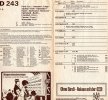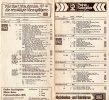All this (very interesting and highly nostalgic) discussion has prompted me to delve into the archives to see which border crossings I did, and when.
1981
Ken Howard and I had long planned a trip to Poland, but our visas were cancelled at short notice due to public unrest. We hurriedly replanned a visit to Saalfeld instead, to see if we could pick up some DR steam locos on passenger workings. We joined D300 the 2227 Munchen – Berlin Friedrichstrasse at Nurnberg, and alighted at Probstzella in the wee small hours of 25th December. We were the only two passengers alighting to travel forward on the local train to Saalfeld, so the border guards gave us a very thorough going over indeed.
After a week in the DDR our exit route was D438 0917 Rostock – Koln via Lubeck.
1982
A second attempt to visit Poland with Ken Howard. This time he had to withdraw at late notice for personal reasons, so I continued alone. This time my route in was D441 2143 Koln – Leipzig via Oebisfelde. My exit into Poland was D499 2209 Leipzig – Krakow via Forst. This train was the preferred way to enter Poland, as it was booked for Pt47 steam haulage from Forst, and was the only train (pair) of the day over that border. That meant you could enter the DDR in the small hours, spend all day in the country bashing track and locos, then fetch up on the “first available train”.
My exit from Poland into the DDR was on D313 2118 Gdansk – Berlin Lichtenberg from Szczecin via Szczecin Gumience. From Lichtenberg I took the S Bahn to Friedrichstrasse, went through the border controls there, then another S Bahn to Berlin Zoo, where I joined D344 1206 Berlin Friedrichstrasse – Hoek van Holland via Helmstedt.
1983
Another trip to Poland. This time we took the easy option with D245 2147 Aachen – Warszawa Gdanska via Helmstedt and Frankfurt (Oder) / Kunowice to enter Poland.
Whilst in Poland, we included a trip on the daily mixed train which crossed into (what is now) Ukraine, in the far south east of Poland, thus doing another couple of dodgy borders.
The return trip from Poland to the UK was via Hungary, Czechoslovakia and Austria, so didn’t involve the DDR.
1984
Poland again, I repeated the use of Oebisfelde crossing on D441, a day in the DDR, then D499 via Forst. The journey back to the UK was via D240 1055 Brest – Aachen via Frankfurt Oder to Berlin Ostbahnhof, where I joined D328 2200 Berlin Zoo – Kobenhavn, That took me to Denmark via Warnemunde Ferry, and a happy time with MX, MY and MZ diesels.
A second trip to Poland later in the year saw me using D441 via Oebisfelde and D499 via Forst again. My return this time was D484 0732 Krakow – Koln via Gorlitz. D409 1546 Rostock – Munchen took me via Gutenfurst to Hof.
To round out the year I did another trip to Poland. D453 0953 Monchengladbach – Leipzig took me via Gutenfurst. I stuck with the train all the way to Leipzig for the usual connection into D499 via Forst. The return from Poland in January 1985 was on the balancing working D498 1820 Krakow – Leipzig via Forst. I exited via Oebisfelde once more.
1985
Another move via Denmark and the Gedser – Warnemunde ferry, then eventually back into DB territory via Probstzella. (Both DB and DR were holding railway celebrations in 1985).
At the end of the year I did another Polish trip, this time entering the DR via Probstzella and continuing into Poland via Gorlitz on D1487 1602 Zwickau – Warszawa Wschodnia dated service, which had a PKP Ty2 steam loco working it from Gorlitz to Legnica. The return trip was rather more conventional, on D240 1125 Brest – Paris Nord via Frankfurt Oder and Helmstedt.
1986
An October trip to Poland saw me – unusually – choosing to fly from Glasgow to Berlin and return. I flew to / from Tempelhof Airport, which is now closed. The details of the moves from the airport to central Berlin and vice versa have been lost. I assume I went once more via S Bahn to Friedrichstrasse, crossed to the DDR there, and continued by S Bahn to Lichtenberg. There I picked up D716 1623 Leipzig – Stralsund as far as Angermunde, dropping back there onto D312 2013 Berlin Lichtenberg – Gdynia via Gumience and Szczecin. The return was once again on D240 via Frankfurt Oder to Berlin Zoo.
Another end of year Polish trip, this time on D451 2348 Frankfurt – Warszawa Wschodnia via Gerstungen - Fortha - Eisenach, which was a route constructed by the DDR to keep corridor trains clear of the border zone area. It has since closed. I continued into Poland on D485 2145 Koln – Krakow via Gorlitz / Wegliniec.
The return was on D1498, a dated 1828 Katowice – Leipzig service via Forst. Amazingly this was worked by a Ty2 2-10-0 Kriegslok from Legnica to Zagan, where a Pt47 2-8-2 took over to Forst. I crossed into West Germany on D436 0840 Leipzig – Hamburg Altona via Buchen.
1987
The customary end of year trip to Poland. This time I went via Hoek van Holland and joined D345 0711 to Berlin Friedrichstrasse, via Marienborn / Helmstedt. Crossed into East Berlin at Friedrichstrasse, then S Bahn to Lichtenberg to end up at Frankfurt Oder for D247 1312 Koln – Leningrad. The return journey a couple of weeks later was by the same route.
1988
Another Polish trip, keeping it simple. Out via Gerstungen – Fortha – Eisenach, crossing into Poland at Forst. The return was via Gorlitz – once again a Ty2 2-10-0 hauling the train, then via Reichenbach and Gutenfurst to Hof.
1989
A July trip to Czechoslovakia for various steam events ended with me coming home via Poland and Germany. Again fairly straightforward, D244 from Rzepin via Frankfurt (Oder) and on via the newly named Berlin Hauptbahnhof (formerly Ostbahnhof). I stayed on D244 through to Berlin Zoo, then dropped back onto D1244 via Helmstedt.
The Berlin Wall fell on 9th November 1989, and the process of German Reunification began. One of the first tangible changes to the railway network (outside Berlin) was the reopening of Walkenried to Ellrich to passenger trains, which I first travelled over on 11/01/90.

 - here's some scans from an 'Ihr Zug Begleiter' leaflet I kept from my trip from Minden to West Berlin on train D243 Paris-Warsaw in April 1977 which shows an example of the schedule of a transit train. The wait at Marienborn was only 5 minutes but my recollection was that border officers boarded the train there and issued transit visas while the train was on its way across the GDR. I also remember that there was a short stop at Griebnitzsee (not shown in the leaflet) just before entry into West Berlin where the officers left the train.
- here's some scans from an 'Ihr Zug Begleiter' leaflet I kept from my trip from Minden to West Berlin on train D243 Paris-Warsaw in April 1977 which shows an example of the schedule of a transit train. The wait at Marienborn was only 5 minutes but my recollection was that border officers boarded the train there and issued transit visas while the train was on its way across the GDR. I also remember that there was a short stop at Griebnitzsee (not shown in the leaflet) just before entry into West Berlin where the officers left the train.


